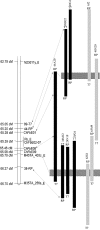Identification of serine/threonine kinase and nucleotide-binding site-leucine-rich repeat (NBS-LRR) genes in the fire blight resistance quantitative trait locus of apple cultivar 'Evereste'
- PMID: 21535354
- PMCID: PMC6640535
- DOI: 10.1111/j.1364-3703.2010.00690.x
Identification of serine/threonine kinase and nucleotide-binding site-leucine-rich repeat (NBS-LRR) genes in the fire blight resistance quantitative trait locus of apple cultivar 'Evereste'
Abstract
Fire blight is the most destructive bacterial disease affecting apple (Malus×domestica) worldwide. So far, no resistance gene against fire blight has been characterized in apple, despite several resistance regions having been identified. A highly efficacious resistance quantitative trait locus (QTL) was localized on linkage group 12 (LG12) of the ornamental cultivar 'Evereste'. A marker previously reported to be closely linked to this resistance was used to perform a chromosome landing. A bacterial artificial chromosome (BAC) clone of 189 kb carrying the fire blight resistance QTL was isolated and sequenced. New microsatellite markers were developed, and the genomic region containing the resistance locus was limited to 78 kb. A cluster of eight genes with homologies to already known resistance gene structures to bacterial diseases was identified and the corresponding gene transcription was verified. From this cluster, two genes were recognized in silico as the two most probable fire blight resistance genes showing homology with the Pto/Prf complex in tomato.
Molecular Plant Pathology © 2011 BSPP and Blackwell Publishing Ltd. No Claim to Original US Government Works.
Figures






References
-
- Abril, J.F. and Guigo, R. (2000) gff2ps: visualizing genomic annotations. Bioinformatics, 16, 743–744. - PubMed
-
- Aldrich, J. and Cullis, C.A. (1993) CTAB DNA extraction from plant tissues. Plant Mol. Biol. Rep. 11, 128–141.
-
- Arumanagathan, K. and Earle, E.D. (1991) Nuclear DNA content of some important plant species. Plant Mol. Biol. Rep. 9, 241.
-
- Belfanti, E. , Silfverberg‐Dilworth, E. , Tartarini, S. , Patocchi, A. , Barbieri, M. , Zhu, J. , Vinatzer, B.A. , Gianfranceschi, L. , Gessler, C. and Sansavini, S. (2004) The HcrVf2 gene from a wild apple confers scab resistance to a transgenic cultivated variety. Proc. Natl. Acad. Sci. USA, 101, 886–890. - PMC - PubMed
-
- Bent, A.F. , Kunkel, B.N. , Dahlbeck, D. , Brown, K.L. , Schmidt, R. , Giraudat, J. , Leung, J. and Staskawicz, B.J. (1994) RPS2 of Arabidopsis thaliana: a leucine‐rich repeat class of plant disease resistance genes. Science, 265, 1856–1860. - PubMed
Publication types
MeSH terms
Substances
LinkOut - more resources
Full Text Sources
Research Materials
Miscellaneous

